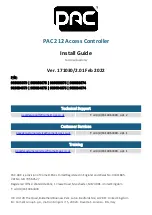
Rev. 1.20
1�6
�an�a�� 2�� 201�
Rev. 1.20
1�7
�an�a�� 2�� 201�
BS82B12A-3/BS82C16A-3/BS82D20A-3
Touch Key 8-Bit Flash MCU with LED/LCD Driver
BS82B12A-3/BS82C16A-3/BS82D20A-3
Touch Key 8-Bit Flash MCU with LED/LCD Driver
INTC3 Register
Bit
7
6
5
4
3
2
1
0
Name
—
—
—
LVDF
—
—
—
LVDE
R/W
—
—
—
R/W
—
—
—
R/W
POR
—
—
—
0
—
—
—
0
Bit 7~5 Unimplemented, read as "0"
Bit 4
LVDF
:
LVD
i
nterrupt
r
equest
f
lag
0: No request
1: Interrupt request
Bit 3~1
Unimplemented, read as "0"
Bit 0
LVDE
: LVD interrupt control
0:
D
isable
1:
E
nable
Interrupt Operation
When the conditions for an interrupt event occur, such as a Touch Key Counter overflow, a TM
Comparator P or Comparator A match, etc, the relevant interrupt request flag will be set. Whether
the request flag actually generates a program jump to the relevant interrupt vector is determined by
the condition of the interrupt enable bit. If the enable bit is set high then the program will jump to
its relevant vector; if the enable bit is zero then although the interrupt request flag is set an actual
interrupt will not be generated and the program will not jump to the relevant interrupt vector. The
global interrupt enable bit, if cleared to zero, will disable all interrupts.
When an interrupt is generated, the Program Counter, which stores the address of the next instruction
to be executed, will be transferred onto the stack. The Program Counter will then be loaded with a
new address which will be the value of the corresponding interrupt vector. The microcontroller will
then fetch its next instruction from this interrupt vector. The instruction at this vector will usually
be a "JMP" which will jump to another section of program which is known as the interrupt service
routine. Here is located the code to control the appropriate interrupt. The interrupt service routine
must be terminated with a "RETI", which retrieves the original Program Counter address from
the stack and allows the microcontroller to continue with normal execution at the point where the
interrupt occurred.
The various interrupt enable bits, together with their associated request flags, are shown in the
accompanying diagrams with their order of priority. Every interrupt source has its own individual
vector. Once an interrupt subroutine is serviced, all the other interrupts will be blocked, as the global
interrupt enable bit, EMI bit will be cleared automatically. This will prevent any further interrupt
nesting from occurring. However, if other interrupt requests occur during this interval, although the
interrupt will not be immediately serviced, the request flag will still be recorded.
If an interrupt requires immediate servicing while the program is already in another interrupt service
routine, the EMI bit should be set after entering the routine, to allow interrupt nesting. If the stack
is full, the interrupt request will not be acknowledged, even if the related interrupt is enabled, until
the Stack Pointer is decremented. If immediate service is desired, the stack must be prevented from
becoming full. In case of simultaneous requests, the accompanying diagram shows the priority that
is applied. All of the interrupt request flags when set will wake-up the device if it is in SLEEP or
IDLE Mode, however to prevent a wake-up from occurring the corresponding flag should be set
before the device is in SLEEP or IDLE Mode.
















































